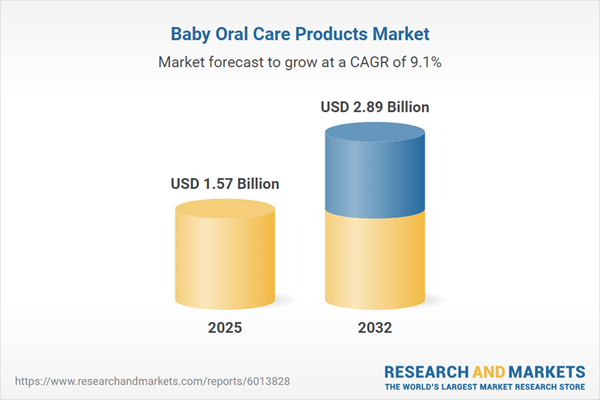Speak directly to the analyst to clarify any post sales queries you may have.
The global baby oral care products market is undergoing significant transformation as regulatory requirements heighten, parental needs evolve, and digital engagement becomes integral to strategy. Senior decision-makers require up-to-date, actionable insights to remain ahead in this competitive segment and ensure that corporate initiatives align with rapidly shifting market dynamics.
Market Snapshot: Global Baby Oral Care Products Market
The global baby oral care products market demonstrates a robust compound annual growth rate (CAGR), reflecting steady progression and fluid industry changes that influence executive decision-making. An upsurge in awareness among families regarding early oral hygiene is propelling organizations to revisit their offerings and anticipate evolving parental expectations. Market leaders are focusing on proactive education and timely intervention, which reshapes innovation cycles and deepens consumer interaction. The integration of digital platforms now empowers both manufacturers and caregivers to promote sustainable oral care practices efficiently. Diverse regional regulations and levels of parental awareness are compelling companies to tailor strategies at the local level, emphasizing market responsiveness and adaptability.
Scope & Segmentation in the Baby Oral Care Products Market
This report delivers comprehensive segmentation supporting strategic choices and product development across all points of the baby oral care value chain:
- Product Types: Dental floss, mouthwash, teething gels, innovative toothbrush formats, and packaging options provide solutions for specific caregiver concerns and different developmental milestones.
- Distribution Channels: Omnichannel models are reinforced by availability at convenience stores, online retail, traditional pharmacies, baby specialty stores, and supermarkets, broadening reach and consumer access.
- Age Groups: Targeted products for newborns, infants, toddlers, and older children support precise market positioning and age-appropriate formulations.
- Product Forms: Gels, liquids, pastes, and powders enable flexible, customized adoption for both at-home caregivers and professional use, fostering satisfaction across preferences.
- Active Ingredients: A spectrum including varied fluoride levels, organic selections, and non-fluoride alternatives addresses regulatory trends and diverse caregiver priorities.
- Regions: The Americas, Europe, Middle East and Africa, and Asia-Pacific are distinctly considered to account for localized buyer behavior, regulatory frameworks, and market characteristics.
- Key Companies: Industry innovation is led by Colgate-Palmolive, Procter & Gamble, Church & Dwight, Unilever, GlaxoSmithKline, Lion Corporation, Koninklijke Philips, Dabur India, Himalaya Wellness, and Pigeon Corporation.
Segmentation Strategies and the Role of Digital Technology
Detailed segmentation enables precise product positioning and a targeted approach to newly emerging caregiver groups. Accelerating digital adoption, such as incorporating mobile engagement and digital-enabled devices, strengthens producer-end user relationships and promotes sustained oral care habits. Geographic segmentation is vital in aligning with distinct legal and consumer frameworks across multiple regions, optimizing local relevancy and ensuring regulatory compliance.
Key Takeaways for Senior Decision-Makers
- Preventive care orientation is directly influencing both product innovation and educational initiatives, allowing organizations to reinforce healthy habits early and maintain ongoing caregiver engagement.
- Advancement of digital solutions—including smart toothbrushes and companion applications—is reinforcing relationships between brands and caregivers, supporting continuous behavior formation.
- Emergence of direct-to-consumer and subscription services is improving product accessibility and creating reliable touchpoints across diverse geographies.
- Transparency initiatives in sourcing, coupled with sustainable production practices, are meeting evolving expectations from regulators and stakeholders for responsible supply chain operations.
- Ongoing development of regional e-commerce infrastructure, especially in Asia-Pacific and the Middle East, is supporting growth strategies that match established consumer shopping patterns.
- Continued demand for natural and alternative ingredient options is informing multi-region R&D agendas, allowing brands to differentiate and satisfy shifting consumer values.
Tariff Impact on Sourcing and Supply Chain Strategies
Forthcoming tariff changes in the United States prompt many companies in the baby oral care space to revisit and modify global sourcing strategies. Organizations are fortifying relationships with local manufacturers, conducting active negotiations with suppliers, and evaluating private label alternatives to preserve supply chain resilience and control operational expenses. This approach is essential for adapting to volatile international trade conditions and meeting updated tariff and compliance requirements.
Methodology & Data Sources
This report synthesizes insights from secondary research, a thorough review of recent regulatory developments, and in-depth executive interviews spanning manufacturing, pediatric care, and retail. Supply chain mapping and expert competitor benchmarking further support the actionable recommendations tailored for leadership teams.
Why This Report Matters
- Enables executive leadership to efficiently adjust product portfolios and sales approaches as regulatory and consumer expectations evolve in the baby oral care products market.
- Guides organizations through digital transformation and new models of customer engagement, strengthening readiness for industry change and compliance shifts.
- Offers timely market updates and benchmarking for key competitors, facilitating innovation and business agility for senior stakeholders.
Conclusion
This report equips senior leaders to navigate regulatory challenges, capitalize on new business opportunities, and strengthen strategic planning amid a dynamic market environment.
Additional Product Information:
- Purchase of this report includes 1 year online access with quarterly updates.
- This report can be updated on request. Please contact our Customer Experience team using the Ask a Question widget on our website.
Table of Contents
3. Executive Summary
4. Market Overview
7. Cumulative Impact of Artificial Intelligence 2025
Companies Mentioned
The companies profiled in this Baby Oral Care Products market report include:- Colgate-Palmolive Company
- The Procter & Gamble Company
- Church & Dwight Co., Inc.
- Unilever PLC
- GlaxoSmithKline PLC
- Lion Corporation
- Koninklijke Philips N.V.
- Dabur India Limited
- Himalaya Global Holdings Ltd
- Pigeon Corporation
Table Information
| Report Attribute | Details |
|---|---|
| No. of Pages | 191 |
| Published | November 2025 |
| Forecast Period | 2025 - 2032 |
| Estimated Market Value ( USD | $ 1.57 Billion |
| Forecasted Market Value ( USD | $ 2.89 Billion |
| Compound Annual Growth Rate | 9.1% |
| Regions Covered | Global |
| No. of Companies Mentioned | 11 |









